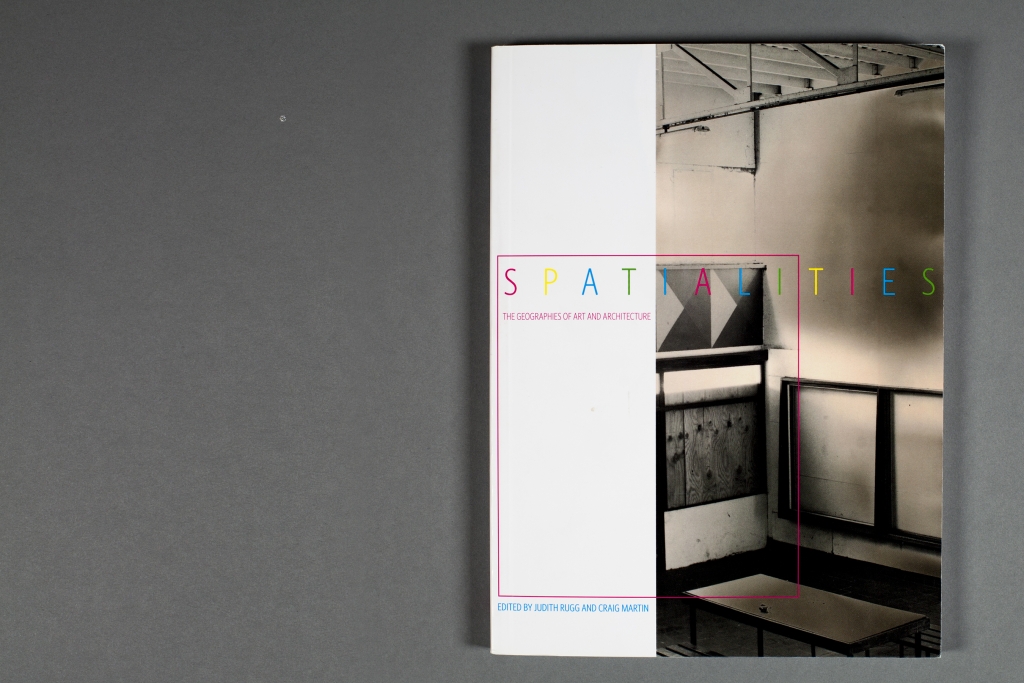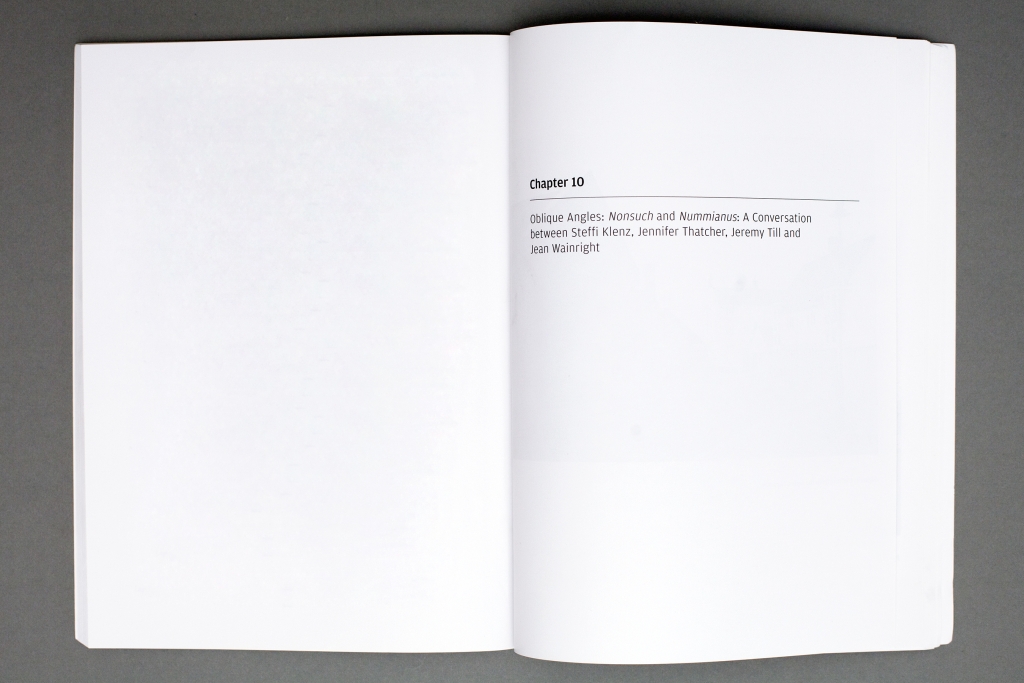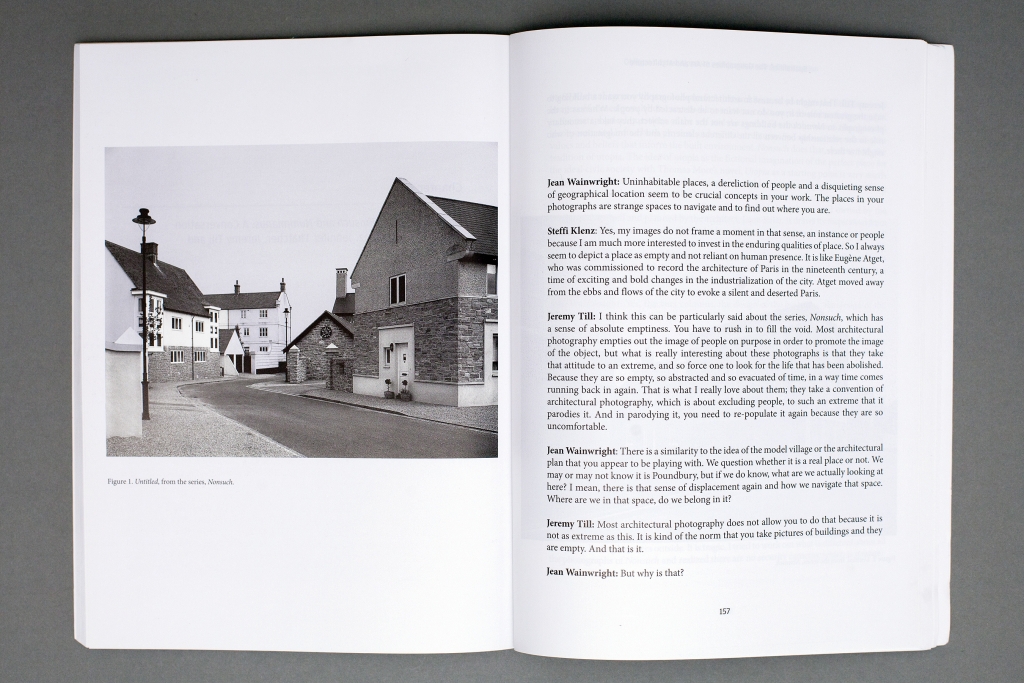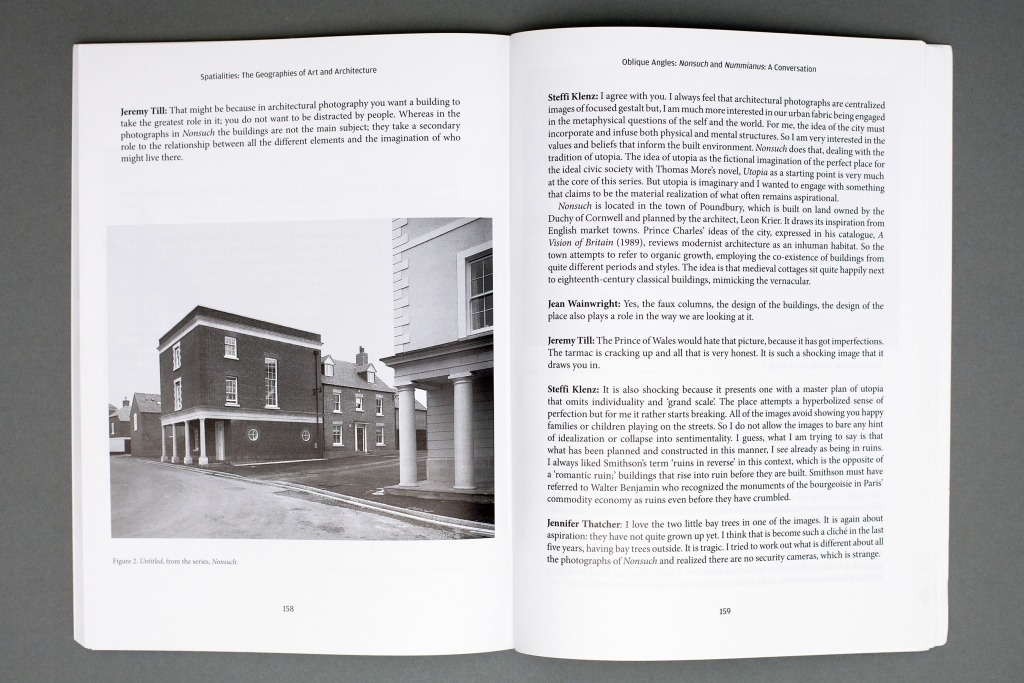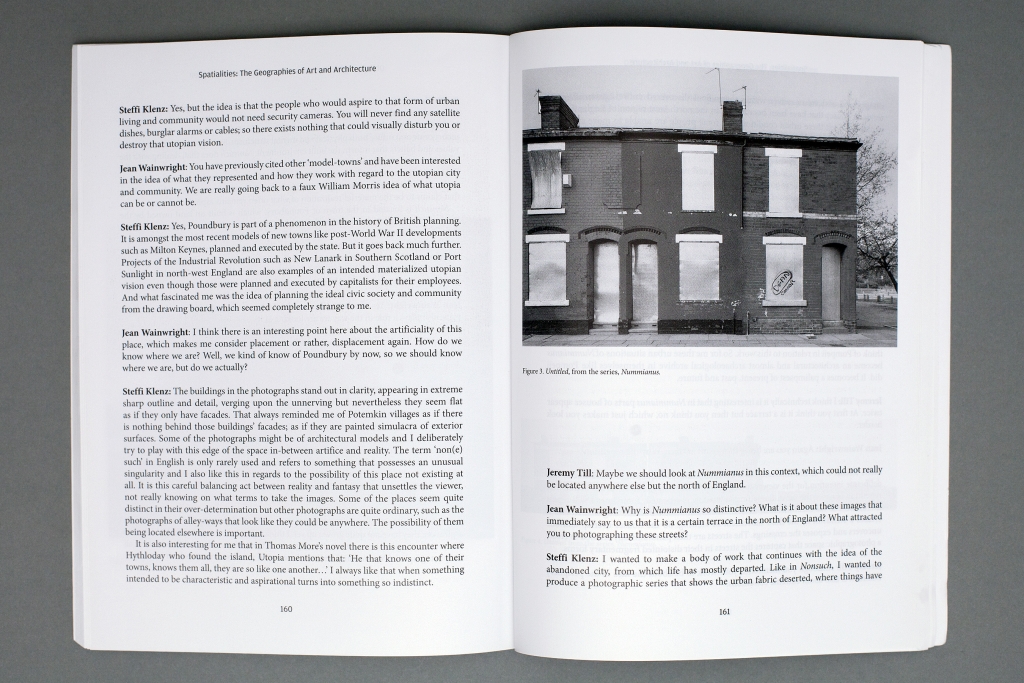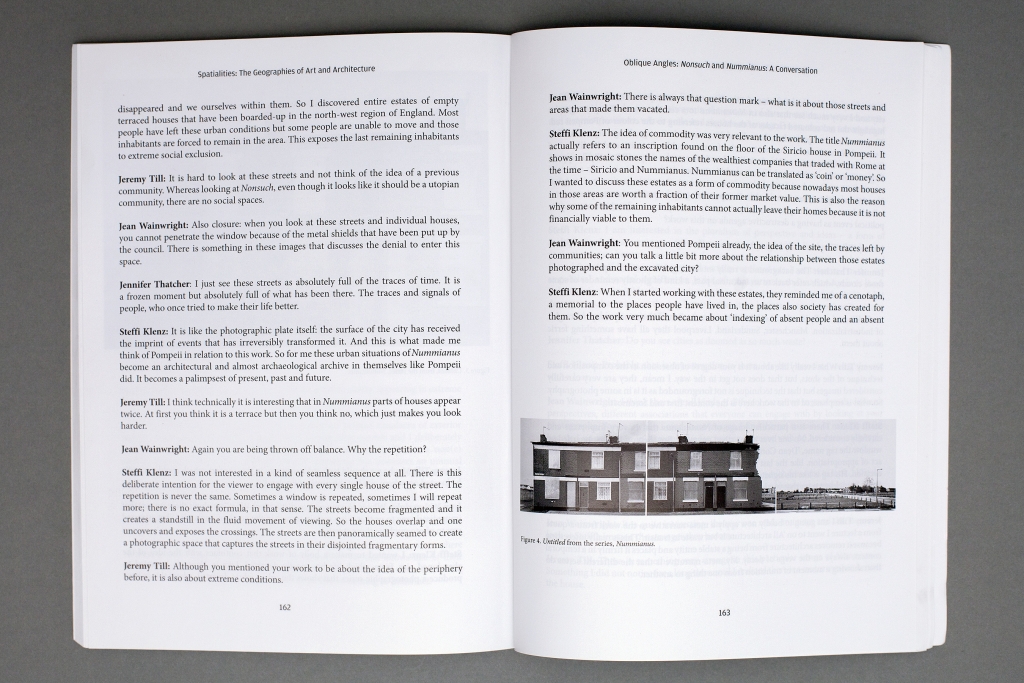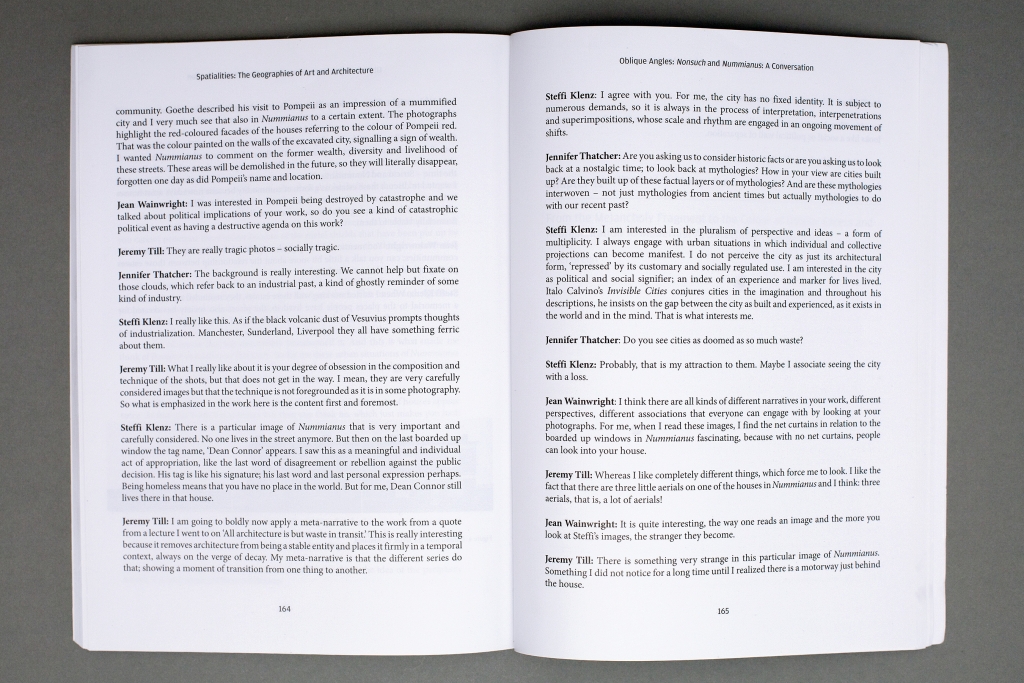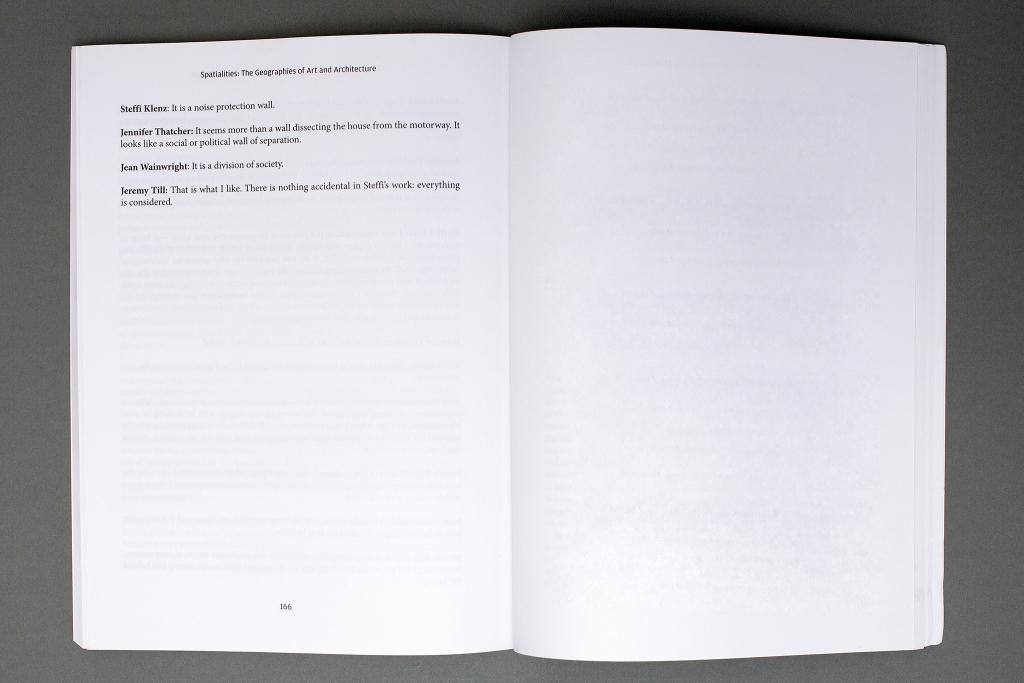Spatialities
Chapter 10
Oblique Angels: Nonsuch and Nummianus: A Conversation between Steffi Klenz, Jennifer Thatcher, Jeremy Tills and Jean Wainwright
JW: Uninhabitable places, a dereliction of people, a lack of scale and a disquieting sense of geographical location seems to be a crucial concepts in your work. The places in your photographs are strange spaces to navigate and to find out where you are.
SK: Yes, my images don’t frame a moment in that sense, an instance or people because I’m much more interested to invest in the enduring qualities of place. So I always seem to depict a place as empty and not reliant on human presence. It is like Eugène Atget, who was commissioned to record the architecture of Paris in the 19th century, a time of exciting and bold changes in the industrialisation of the city. But Atget moved away from the ebbs and flows of the city but rather showed us a silent and deserted Paris.
JTi: I think this can be particularly said about the series “Nonsuch”, which has a sense of absolute emptiness. You have to rush in to fill the void. Most architectural photography empties out the image of people on purpose in order to promote the image of the object, but what’s really interesting about these photographs of “Nonsuch” is that they take that attitude to an extreme, and so force one to look for the life that has been abolished. Because they’re so empty, so abstracted and so evacuated of time,in a way time comes running back in again. That’s what I really love about them; they take the convention of architectural photography, which is always about excluding people, to such an extreme that it parodies it. And in parodying it, you need to re-populate it again because they’re so uncomfortable.
JW: There is a similarity to the idea of the model village or the architectural plan that you appear to be playing with. We question whether it is a real place or not. We may or may not know it’s Poundbury, but if we do know, what are we actually looking at here? I mean, there's that sense of displacement again, how do we navigate that space. Where are we in the space, do we belong in the space?
JTi: Most architectural photography does not allow you to do that because it is not as extreme as this. It's kind of the norm that you take pictures of buildings and they're empty. And that's it.
JW: But why is that?
JTh: That might be because in architectural photography you want a building to take the greatest role in it; you don't want to be distracted by people. Whereas in the photographs of “Nonsuch” the buildings are not the main subject; they take a secondary role to the relationship between all the different elements and the imagination of who might live there.
SK: I agree with you. I always feel that architectural photographs are centralized images of focused gestalt but, I’m much more interested in our urban fabric being engaged in the metaphysical questions of the self and the world. For me the idea of the city must incorporate and infuse both physical and mental structures. So I’m very interested in the values and beliefs that inform the built environment.
So “Nonsuch” very much does that, dealing with the tradition of utopia. The idea of utopia as the fictional imagination of the perfect place for the ideal civic society with Thomas More’s novel “Utopia” as a starting point is very much at the core of this series. But utopia is imaginary and I wanted to engage with something that claims to be the material realisation of what often remains aspirational. “Nonsuch” is located in the town of Poundbury, which is built on land owned by the Duchy of Cornwell and planned by the architect Leon Krier, It draws its inspiration from English market towns. Prince Charles’ ideas of the city, expressed in his catalogue “A Vision of Britain” (1989), reviews modernist architecture as an inhuman habitat. So the town attempts to refer to organic growth, employing the co-existence of buildings from quite different periods and styles. The idea is that medieval cottages sit quite happily next to 19th century classical buildings, mimicking the vernacular.
JW: Yes, the faux columns, the design of the buildings, the design of the place also plays a role in the way we're looking at it.
JTi: The Prince of Wales would hate that picture, because it has got imperfections. The tarmac is cracking up and all that is very honest. It's such a shocking image that it draws you in.
SK: It is also shocking because it presents one with a master plan of utopia that omits individuality and ‘grand scale’. The place attempts a hyperbolized sense of perfection but for me it rather starts breaking. All of the images avoid showing you happy families or children playing on the streets. So I do not allow the images to bare any hint of idealization or a collapse into sentimentality. I guess, what I’m trying to say is that what has been planned and constructed in this manner, I see already as being in ruins. I always liked Smithson’s term ‘ruins in reverse’ in this context, which is the opposite of a ‘romantic ruin’; buildings that rather rise into ruin before they are built. Smithson must have referred to Walter Benjamin of course who recognises the monuments of the bourgeoisie in Paris’ commodity economy as ruins even before they have crumbled.
JTh: I love the two little bay trees in one of the images. It's again about aspiration: they haven't quite grown up yet. I think that's become such a cliché in the last 5 years, having bay trees outside. It’s tragic. I tried to work out what is different about all the photographs of “Nonsuch” and realized there are no security cameras, which is strange.
SK: Yes but the idea is that the people who would aspire to that form of urban living and community would not need security cameras. You will never find any satellite dishes, burglar alarms or cables; so there exists nothing that could visually disturb you or destroy that utopian vision.
JW: You have previously cited other ‘model-towns’ and have been interested in the whole idea of what they represented and how they work in regards to the utopian city and community. We're really going back to a faux William Morris idea of what Utopia can be or can't be.
SK: Yes, Poundbury is part of a phenomenon in the history of British planning. It is amongst the most recent models of new towns like post World War 2 developments such as Milton Keynes, planned and executed by the state. But it goes back much further. Projects of the Industrial Revolution such as New Lanark in Southern Scotland or Port Sunlight in North-West England are also examples of an intended materialized utopian vision even though those were planned and executed by capitalists for their employees. And what fascinated me was the idea of planning the ideal civic society and community from the drawing board, which seemed completely strange to me.
JW: I think there's an interesting point here about the artificiality of this place, which makes me consider placement or rather displacement again. How do we know where we are? Well, we kind of know of Poundbury now, we should know where we are, but do we actually?
SK: The buildings in the photographs stand out in clarity, appearing in extreme sharp outline and detail, verging upon the unnerving but nevertheless they seems flat as if they only have facades. That always reminded me of Potemkin villages as if there is nothing behind those buildings’ facades as if they are painted simulacra of exterior surfaces. Some of the photographs might be of architectural models and I deliberately try to play with this edge of the space in-between artifice and reality. The term non(e)such in English is only rarely used and refers to something that possesses an unusual singularity and I also like this in regards to the possibility of this place not existing at all. It is this careful balancing act between reality and fantasy that unsettles the viewer, not really knowing on what terms to take the images. Some of the places seem quite distinct in their over-determination but other photographs are quite ordinary. Photographs of alleyways that look like they could be anywhere. The possibility of them being located elsewhere is important.It is also interesting for me that in Thomas More’s novel there is this encounter where Hythloday who found this island Utopia mentions that: “He that knows one of their towns, knows them all, they are so like one another…” I always like that when something intended to be characteristic and aspirational turns into something so indistinct.
JTh: Maybe we should look at“Nummianus” in this context, which couldn't really be located anywhere else but the North of England.
JW: Why is “Nummianus” so distinctive? What is it about these images that immediately say to us that it’s a certain terrace in the North of England What attracted you to photographing these streets?
SK: I wanted to make a body of work that continues with the idea of the abandoned city, from which life has mostly departed. Like in “Nonsuch” I wanted to produce a photographic series that shows the urban fabric deserted, where things have disappeared and we ourselves within them. So I discovered entire estates of empty terraced houses that have been boarded-up in the North-West regions of England. Most people have left these urban conditions but some people are unable to sell their homes and those inhabitants are forced to remain in the area. This exposes the last remaining inhabitants to extreme social exclusion.
JTh: It’s hard to look at these streets and not think of the idea of a previous community. Whereas looking at Poundbury, even though it looks like it should be a Utopian community, there are no social spaces.
JW: Also closure: when you look at these streets and individual houses, you can’t penetrate the window because of the metal shields that have been put up by the council. There is something in these images that discusses the denial to enter this space.
JTh:I just see these streets as absolutely full of the traces of time. It’s a frozen moment but absolutely full of what’s been there. The traces and signals of people, who once tried to make their life better.
SK: It is like the photographic plate itself: the surface of the city has received the imprint of events that has irreversibly transformed it. And this is what made me think of Pompeii in relation to this work. So for me these urban situations of “Nummianus” become an architectural and almost archeological archive in themselves like Pompeii did. It becomes a palimpsest of present, past and future.
JTi: I think technically it’s interesting that in “Nummianus” parts of houses appear twice. At first you think it’s a terrace but then you think no, which just makes you look harder.
JW: Again you’re being thrown off balance. And why the repetition?
SK: I wasn’t interested in a kind of seamless sequence at all. There is this deliberate intention for the viewer to engage with every single house of the street. The repetition is never the same. Sometimes a window is repeated, sometimes I’ll repeat more; there’s no exact formula, in that sense. The streets become fragmented and it creates a standstill in the fluid movement of viewing. So the houses overlap and one uncovers and exposes the crossings. The streets are then panoramically seamed to create a photographic space, that captures the streets in their disjointed fragmentary forms.
JTi: Although you mentioned your work to be about the idea of the periphery, it is also about extreme conditions.
JTh: When you look at “Nummianus” you realize that this is an extremely unusual situation for a city. Usually vacated properties are at a premium and developers can’t wait to get people to redevelop. And here people are leaving and it’s staying empty. No one wants it.
JW: You wonder why they don’t want it. There’s always that question mark, commodity, the housing market, desirability, because you’re thinking why are they vacated, what is it about those streets and areas that had to be vacated.
SK: It is interesting that you mention this because the idea of commodity was very relevant to the work. The title “Nummianus” actually refers to an inscription found on the floor of the Siricio house in Pompeii. It shows in mosaic stones the names of the wealthiest companies that traded with Rome at the time - Siricio and Nummianus. Nummianus can be translated as coin or money. So, I wanted to discuss these estates as a commodity because nowadays most houses in those areas are worth a fraction of their former market value. This is also the reason why some of the remaining inhabitants can’t actually leave their homes because it is not financially viable to them.
JW: You mentioned Pompeii already, the idea of the site, the traces left by communities; can you talk a little bit more about the relationship between those estates photographed and the excavated city?
SK: When I started working with these estates in the North-West regions, they reminded me of a cenotaph, a memorial to the places people have lived in, the places also society has created for them. So the work very much became about ‘indexing’ of absent people and an absent community. Goethe described his visit to Pompeii as an impression of a mummified city and I very much see that also in “Nummianus” to a certain extend. The photographs highlight the red-coloured facades of the houses referring to the colour of Pompeii red. That was the colour painted on the walls of the excavated city, signalling a sign of wealth. I wanted “Nummianus” to comment on the former wealth, diversity and livelihood of these streets. By referring to Pompeii, it also perishes the present state of these streets as hopeless in what is to come. These areas will be demolished in the future. So they will literally disappear, forgotten one day like did Pompeii’s name and location.
JW: I was interested in Pompeii being destroyed by catastrophe and we talked about political implications of your work, so do you see a kind of catastrophic political event as having a destructive agenda on this work?
JTi: It’s got to be! It’s tragic! They are really tragic photos - socially tragic.
JTh: The background is really interesting. We can’t help but fixate on those clouds, which refer back to an industrial past, a kind of ghostly reminder of some kind of industry.
SK: I really like this. As if the black volcanic dust of Vesuvius prompts thoughts of industrialization. Manchester, Sunderland, Liverpool they all have something ferric about them.
JTi: What I really like about it is your degree of being obssessional in the composition and technique of the shots but it doesn’t get in the way. I mean, they’re very carefully considered images but that the technique is not foregrounded as it is in some photography. So what is emphasized in the work here is the content first and foremost.
SK: There’s a particular image of “Nummianus” that’s very important and carefully considered. No one lives in the street anymore. But then on the last boarded up window the name Dean Connor appears. I saw this as a meaningful and individual act of appropriation, like the last word of disagreement or rebellion against the public decision. His tag is like his signature. It is his last word, his last personal expression perhaps before this situation is fully excepted. To have no property or being homeless means that you have not inherited a place in this world. But for me, Dean Connor still lives there in that house.
JTh: It is interesting that you talk about repossession. To me it seems a good starting point to talk about the series “La Posa”. It reminded me of Eyal Weizman’s research into how the Israeli army used domestic buildings to penetrate into enemy space and how therefore domestic buildings become part of the military strategy. Were you thinking about that at all?
SK: Yes, to a degree I was. I’m interested in the idea of the house as an architectural and visual metaphor. The idea of the domestic place as a home, a place of identity, a point of origin and return. The migrant or the repossessed person is made to feel homeless, so to speak out of place. So this really interests me of how one can lose the possibility of aquiring a place in this world. “La Posa” is located in the village of Tyneham in South-West England, which was repossessed by the army for military manoeuvres deemed essential for the war effort in 1943. But it was not the main focus of the series that in this instance it is the Military of Defense (MOD) that applies its authority in aquiring these homes.
JTh: Yes, like Weizman; it talks much more about violation.
SK: This is interesting because at the time I was reading‘Tristes Tropiques’ by Claude Lévi-Strauss. His encounters of his visits to the Amazonian peoples also talk about violation and its relationship to the actual settlements of these South American people. His book laments a ‘lost’ New World in that this idea of colonialism produces a form of 'monoculture' development.
JW: You spoke before about how can one go home or return home? Which struck a chord with me. The fact that these were homes but you can’t go home, you can’t return. “La Posa” is not a home and can never be a home. I think there’s something very surreal and disturbing about that.
JTh: There’s something about these places being a ruin. These fortresses seem mixed with the domestic, almost referring to the South-West Cotswold-kind of architecture. But then there is the military side; it’s quite a strange combination. One of the images in the series looks more like a fossil or something archeological. It actually looks like the wall started growing. Even the military are not using these walls or spaces anymore. So the village has been twice abandoned.
SK: For me, the ruin questions the distinction between interior and exterior, between public and private. “La Posa” aims to deal with that idea of the ruin. It is both house and home because what the viewer sees are these barren walls that offer no emotional particularity, so they talk much more about the exterior, the house. But actually you are looking at the interior space, so the home. “La Posa” empties out the private social space, it becomes open to the public view, turning the space inside out and then there was always this question in my mind of how one can go home if all access to domestic familiarity has been refused.
JW: This is important because you enhanced the images didn’t you?
SK: Well, I blocked out the windows, doors and floors with black-out material. So I do incorporate that element of artifice into the work. There exists a literal impossibility of entering the house itself, a negation of accessibility in that the images offer a ‘blocked vision’. They become blindfolded in that the architectural element of the house that organizes vision is the window as a metaphor for the eye.
JTh: It’s true: it is very difficult to tell whether you’re inside or outside in these images… Because they look like outside walls but then you have got this black material on the floor, which makes it look like a carpet of an interior space.
JTi: I’m going to boldly now apply a meta-narrative of all the work. I would like to use a quote from a lecture I went to, which is “All architecture is but waste in transit”. This is really interesting in my opinion because it removes architecture from being this stable entity, and places it firmly in a temporal context, always on the verge of decay. My meta-narrative is that all the different series’ do that; showing a moment of transition from one thing to another.
SK: I agree with you. For me, the city has no fixed identity. It is subject to numerous demands, so it is always in the process of interpretation, interpenetrations and superimpositions, whose scale and rhythm are engaged in an ongoing movement of shifts.
JTh: I’m just wondering whether you’re asking us to deal with historic facts or whether you’re asking us to look back at a nostalgic time, whether you’re asking us to look back at mythologies? How in your view are cities built up? Are they built up of these factual layers or those mythologies? And are these mythologies interwoven - not just mythologies from ancient times but actually mythologies to do with our recent past?
SK: I am interested in the pluralism of perspective and ideas – a form of multiplicity.I always engage with urban situations in which individual and collective projections can becomes manifest. I don’t perceive the city in its ‘mere’ architectural form, ‘repressed’ by its customary and socially regulated use; so the city as a political and social signifier, but also an index of an experience and marker for lives lived. “Invisible Cities” by Italo Calvino’s conjures cities in the imagination and throughout his descriptions, he insists on that gap between the city as built and experienced, as it exists in the world and in the mind. And that is what interests me.
“Nummianus” is a good example in that for some these are houses in need of repair, for some these are constructions of limited value, for some this is an urban situation worthy of esteem, for some they have become archetypes of a former working class Britain. For me, they are also about the relationship to Pompeii as an example in regards to the destruction of the city. So I don’t think you ever can approach the city without a certain understanding of the past; a certain relation to its past and present narrative whether these are factual layers or myths.
JTh: But if you’re talking about a kind of inevitability, is it inherently negative? Our relationship to cities, do you see them as always negative, as doomed for this waste?
SK: Probably that is my attraction to them. Maybe I associate seeing the city with a loss. Maybe, Robert Smithson has influenced me more then I think. Maybe there is something true in him saying: "I am convinced that the future is lost somewhere in the dumps of the non-historical past.
JW: I think there are all kinds of different narratives in your work, different perspectives, different associations that everyone can engage with by looking at your photographs. For me, when I read these images, I find the net curtains in relation to the boarded up windows in “Nummianus” fascinating, because of so many people saying to me “You have no net curtains, people can look into your house”.
JTi: Whereas I like completely different things, which force me to look. I like the fact that there are three little aerials on one of the houses in “Nummianus” and I think: three aerials, that’s a lot of aerials!
JW: It is quite interesting, the way one reads an image and the more you look at Steffi’s images, the stranger they become.
JTi: There’s something very strange in this particular image of “Nummianus”. Something I did not notice for a long time until I realized there’s a motorway just behind the house.
SK: It’s a noise protection wall.
JTh: It seems more than a wall dissecting the house from the motorway. It looks like a social or political wall of separation.
JW: It’s a division of society.
JTi: That’s what I like. There is nothing accidental in Steffi’s work: everything is considered.
